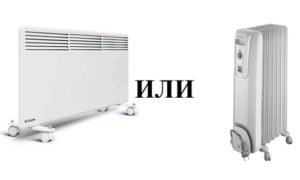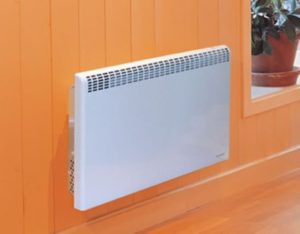 Do not know how to improve comfort in the house, get the desired warmth, get rid of the dampness of the walls? Need an effective appliance that will act as an additional means of heating? Tired of drafts? Rational people who prefer convenient, functional and reliable solutions choose a convector type heater. This device easily solves all problems, winning in comparison with other options in one or more characteristics.
Do not know how to improve comfort in the house, get the desired warmth, get rid of the dampness of the walls? Need an effective appliance that will act as an additional means of heating? Tired of drafts? Rational people who prefer convenient, functional and reliable solutions choose a convector type heater. This device easily solves all problems, winning in comparison with other options in one or more characteristics.
Content
The principle of operation of a convector heater
When choosing a convector type heating device, it is useful to know by what principle it works. The main idea embedded in the design of the installation is the use of natural thermal air convection. In general, the principle of operation looks like this:
- when voltage is applied, the coolant flows, as a result of fuel combustion, the main fuel element heats up;
- high-temperature air rises up inside the device body;
- external air masses enter the convector through openings in the lower part of the body.
With such a mechanic of work, a mass of positive properties is formed, which the convector possesses. This is the formation of an air curtain, safety of use (the heating zone is hidden inside the housing), the availability of several types of energy carrier.
Criterias of choice
Although convectors are good, you should choose them for an apartment or a house, focusing on several indicators of the device. Among them are both the heat transfer power and the dimensions and type of construction.
There are models that are used in a fairly narrow area, showing results that are not available for other solutions. Available on the market and fairly standard appliances similar to oil or infrared heat sources. Let's consider in detail how to choose a convector heater.
Type of heating element
Today on the market you can buy a convector for the home, which is used as the main heating element:
- A plate of mica or another high temperature resistant dielectric, on which a wire of nichrome or other alloy with a high resistance is wound. Such a solution is called a needle (tape) element, it is considered obsolete. The main disadvantage of the device with this heating mechanics is the burning of dust, which inevitably contains air in the room. As a result, not only unpleasant odors are formed, but also the service life of the fuel element is reduced.
- The heating element is based on the heater. This is a convenient, durable solution with good performance indicators. To accelerate heat transfer on the TENA tube, a structure of metal fins is arranged. More modern solutions propose the so-called diffuser, which is a system of partitions in the form of a tube or parallelepiped, where the air is forced to pass along a long path.
- Monolithic heater, sintered silica sand with some additives. Depending on the composition of the mixture (polymers may enter it), the structural element is characterized by a greater or lesser mass. Inside the stone monolith is a heater. Such a solution is considered the most secure, reliable. It was first proposed by the Electrolux company, which has extensive experience working with glass-protected heating elements and spiral heaters.
- Thermal emitting catalytic grating. It is used in convectors, the source of energy of which is combustible gas or liquid fuel.When operating such a device, no flame is generated. The presence of certain additives in the composition of ceramics, of which the catalytic heater consists, makes it possible to achieve the so-called fireless, slow combustion. During this process, a huge amount of heat is released.
The last of the types of heating elements is very preferable if a convector is selected for a summer residence. The device will be effective not only indoors. You can choose a model whose power will be enough to heat the gazebo or porch.
We calculate the required power
There are two methods for calculating the sufficient power of the device in accordance with the indicators of the room that it will be heated. The characteristics of the convector according to the first scheme are calculated simply: an area per square meter will require 100 watts of heat. At the same time, it is assumed that the ceiling height is standard for the apartment and ranges from 2.5 to 3 meters, and the quality of housing insulation complies with industry standards SNiP.
The second technique is somewhat more complicated. The ceiling height and type of heating (main or additional) are taken into account. The power of the device is determined as follows:
- the volume of the room is calculated by multiplying the floor area by the height of the ceilings;
- if the convector will act as the main means of heating, 40-45 watts of heat will be required to heat a cubic meter of space;
- in the variant when it is required to obtain only an additional source of heat, 25 watts of heat generation of the convector are allocated per cubic meter of room.
In general, a room with ceilings of 3 meters and a floor area of 20 squares is able to heat one appliance with a capacity of 2400-2700 watts. This is a figure by the second method. The first method of calculation in this case shows 2000 watts.
Tactics on how to choose a convection heater correctly look simple. If the room is insulated, there are no drafts in it - you can stop on a device with a capacity of 2000 watts. In cases where there is dampness or heat loss, it is better to prefer a model with the maximum calculated heat release rate.
In our article you can find out in more detail how to calculate heater power and based on these data make the right choice.
Installation Method, Dimensions
It is simply impossible to clearly describe what dimensions a typical convector has. The first reason is the availability of various designs and installation procedures. In the mass market are offered:
- floor convectors;
- mounted on the wall;
- located in the form of a plinth around the entire perimeter of the room;
- installed inside the floor.
You can buy a wall convector that looks like a vertical panel. There are small products that are installed on the windowsill inside the space of the window opening. Therefore, the choice of convector dimensions is very wide and there is no difficulty in acquiring a product that will be convenient and at the same time functional and efficient.
The most popular among consumers is the floor version. Such a convector is convenient as a means of additional heating, can be easily moved, and is safe.
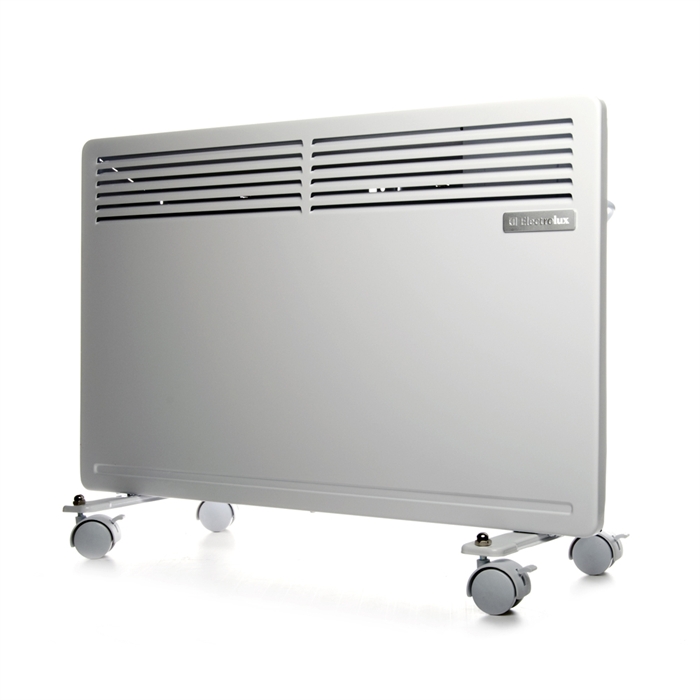
Which is better: oil or convection
At the beginning of the article, it was mentioned that convectors outperform each of the common solutions by one or more characteristics. We will arrange a contest between a classic oil heater and a modern convection device.
- The amount of heat generated by both classes of devices is the same with approximately equal power consumption. But at the same time, the convector forms a more intense air curtain to protect against drafts. At the same time, warming up the room is faster. Even with a fan, the oil heater is not able to guarantee the same speed of comfort, since it takes more time to heat up the coolant.
- Convector safety is higher. Here all the fuel elements are inside the case, they cannot be touched, only hot air comes out of the device.
- Convenience of using a convector, if we consider the floor version, is higher. The design is lighter, it does not have a heavy amount of oil.
- By the number of available versions, the convector wins again. You cannot purchase an underfloor or baseboard class oil heater. Inaccessible and solutions in the form of small blocks installed on the windowsill.
We can note areas where the comparison of who is better - a convector or an oil heater - shows almost equal results. Both solutions show approximately the same energy consumption indicators, offer almost the same comfort for wall-mounted installation. In all other areas, the convector wins.
Note to home masters. Oil can be used with success as a heat carrier in liquid skirting convectors of the plinth type, as well as underfloor. Such a filler of the circuit will not freeze, so you can equip the cottage with a frost-resistant solution that will quickly give heat if the family has arrived, for example, to celebrate the New Year.
Which is better: infrared or convection
Considering which convection heater is better, it is impossible not to compare them with today's infrared installations.
- Convector safety level is higher. It does not act with direct radiation, objects can be placed near it, since the air temperature at the outlet is stable and quite low.
- Infrared heater loses in versions. There are no floor models, it is impossible to find products of this class in the format of a warm baseboard.
- For the complexity of installation, an infrared gas heater, for example, from the Ballu brand loses to convection solutions. The latter do not need to be suspended from the ceiling, maintaining a clear distance to avoid fire. Easier routing of fuel supply.
- The convector warms the entire room, forming thermal curtains and raising the temperature in the entire volume of the room. An infrared heater simply does not have such functionality. It shines like a searchlight, heating objects that unevenly absorb and give off heat.
- An infrared heater is capable of creating discomfort, being aimed at a person at close range. The convector does not have such a drawback.
As can be seen from honest enumerations of known features and their direct comparison, the convector also beats infrared solutions. But do not think that this version of the device is always at the top of the preference rating. There are narrow segments where, due to the low price or increased usability, oil or infrared heating devices can win.
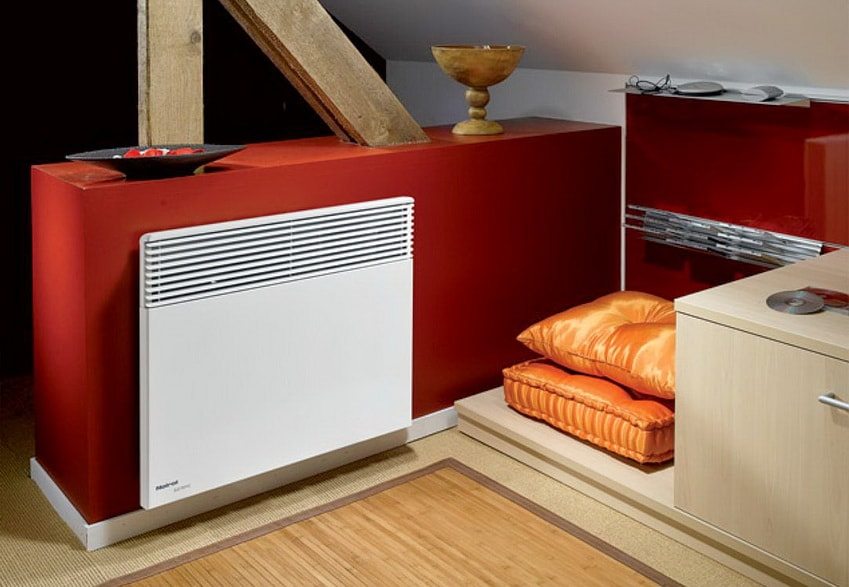
Convection heaters - pros and cons
In order to immediately debunk all the myths regarding the features of using a convector, we will immediately arrange their brief, thesis debunking.
- The device consumes a lot of energy. This is not true. A convector with a temperature regulator is able to function in a stable mode, supporting certain indicators of heating of the heat-generating zone. The availability of external sensors further reduces energy bills.
- The convector is cracking and noisy. This can only be said about cheap solutions where a needle heater is used. Crackling and noise are observed only in extremely humid or dusty rooms. The modern model of the convector with a monolithic heater works silently even in the bathroom. To enjoy the silence, you just need to carefully select the heater device in accordance with the future conditions of its operation.
- Oil, infrared heaters, convectors - all work on a different element base. This is also not true. They have different methods of heat transfer. In particular, Thermor produces all of these instrument classes.
Now let's move on to the list of pluses and minuses of convective thermal installation. The undoubted advantages include:
- the formation of an intense air curtain;
- simplicity and safety of operation;
- availability of regulation of work, including using external sensors;
- Price, which is formed honestly, based on the type of fuel element;
- efficient, quick heat transfer;
- silent work;
- Efficiency at 95% for electrical solutions.
Some of the disadvantages, which are also able to act as selection criteria, include the features of individual design types of convectors:
- electric spiral, needle, tape heaters gradually fade, the efficiency of heat transfer decreases. This cannot be said about heating elements or monolithic fuel blocks;
- for a gas convector, a separate chimney through the wall and the laying of a fuel supply path will be required. At the same time, the overall heating efficiency of a large house will be higher, and the cost will be lower if a central heating boiler is used;
- floor convectors, as well as solutions of the “warm skirting” format, are the less effective the greater the height of the ceilings. It takes a long time to warm up the room; the system may not be able to cope if there are drafts or significant heat losses from, for example, a door that is constantly opening and closing.
However, the advantages, the list of which is much more impressive, outweigh all the disadvantages of convectors of different types. This is more understandable when you consider that the above disadvantages are rather features of individual designs of the heating device.
The best models
Concluding the story about the selection methodology and features of different classes of devices, here are some prominent representatives of the mass market. It is impossible to say unequivocally which company a convection heater is better. Each device segment has its own leader.
In the field of interesting solutions for the home, the Electrolux brand is the leader. The Electrolux ECH / AG-2000MFR model is designed to heat a room with an area of 25 squares, equipped with a thermostat of a mechanical type of increased reliability, allows two types of installation (floor or wall). Wheels, protection against overheating, moisture, as well as a special system for cleaning air from dust are offered. And at the same time, the indicator of how much electricity this wonderful device consumes is quite unexpected. Only 1000 watts in stable heat transfer mode. At maximum, the convector will require 2000 watts from the grid.
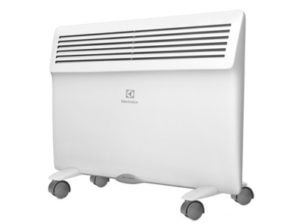
The Hosseven brand leads the segment in good gas solutions. The range of HHS convectors is safe (closed combustion chamber), economical (efficiency up to 86%), devices of different capacities are offered, there is the possibility of wall mounting, as well as location at any point. For this, the device is equipped with a telescopic or coaxial chimney. The ignition start can be made from one AA battery, which is invaluable if you need to organize heating in the country.
Among the in-floor water solutions, the EVA brand leads the way. Convectors of various sizes, capacities, with convenient adjustment and a decorative protective grill that can be removed by winding into a roll, are offered. At the same time, devices have increased safety indicators. For example, the EVA KX.125.203.900 model works with a pressure of up to 16 atm, with a critical rate of 25. The permissible temperature of the circulating liquid is up to 115 degrees.
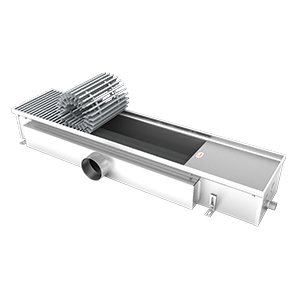
The leadership in the segment of monolithic heater convectors belongs to the brands Electrolux and Zanussi. The Electrolux ECH / AG21000EF model looks interesting. With a power of 1000 watts at maximum, it is able to heat a room of 15 squares, there is protection against overheating, two modes of operation, and temperature control. The product is lightweight, moves on comfortable wheels. Wall mounting allowed.
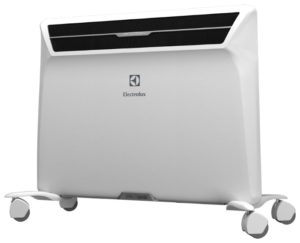
If you have not chosen anything among the models presented above, be sure to check our convector rating.
